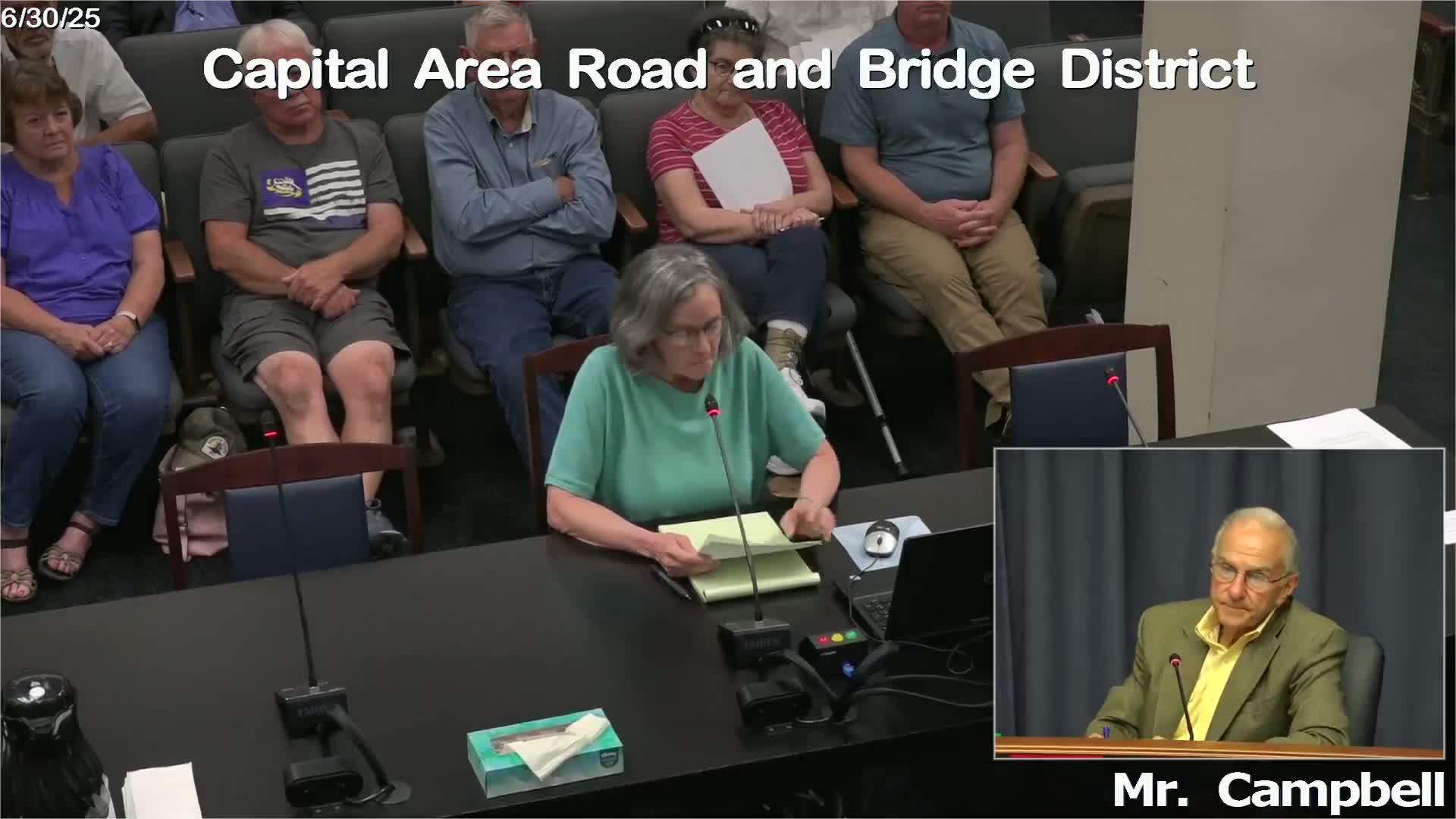Plaquemines Point residents oppose E 11 4 bridge project citing environmental concerns
June 30, 2025 | Capital Area Road and Bridge District, Boards & Commissions, Organizations, Executive, Louisiana
This article was created by AI summarizing key points discussed. AI makes mistakes, so for full details and context, please refer to the video of the full meeting. Please report any errors so we can fix them. Report an error »

In a meeting that echoed with the concerns of local residents, the Capital Area Road and Bridge District (CARB D) convened on June 30, 2025, to discuss the ongoing project development phase of a significant infrastructure initiative. The atmosphere was charged with urgency as community members voiced their apprehensions regarding the proposed E 11 4 bridge alternative, which they argue threatens the integrity of an old-growth forest in Plaquemines Point.
The discussions began with a recap of the project's timeline, highlighting a public comment period that had recently closed. The Parish President of Iberville noted that consultants had identified three primary alternatives for the project, but emphasized the necessity of community engagement to comply with federal regulations. This sentiment was echoed by the Parish President of Vaperville, who advocated for E 11 4 as the best option for industrial growth.
However, the meeting quickly shifted focus to the environmental implications of the proposed route. Residents raised alarms about the potential destruction of ancient trees and the ecological significance of the area. They presented evidence of prior communications with the Louisiana Department of Transportation and Development (DOTD), detailing their efforts to inform officials about the ecological and historical importance of the land. The community's concerns were underscored by a December 2023 planning report that they believe downplayed the environmental impacts of the E 11 4 alternative.
As speakers took turns sharing their testimonies, the narrative of the meeting unfolded—a tale of a community fighting to protect its heritage and environment against what they perceive as a predetermined outcome favoring industrial development. They highlighted the historical significance of Plaquemines Point, tracing back to Acadian settlements and the cultural legacy of the land.
The residents' passionate appeals were supported by documentation submitted to the DOTD, including letters from local landowners and environmental organizations opposing the bridge's proposed path. They argued that the planning process had overlooked critical data regarding the area's old-growth forest, which cannot be replaced once destroyed.
As the meeting drew to a close, the implications of the discussions lingered in the air. The community's resolve to safeguard their natural and historical resources was palpable, leaving attendees to ponder the future of the E 11 4 alternative and the balance between development and preservation. The CARB D's next steps will be crucial in determining whether the voices of the residents will be heard in the ongoing project development process.
The discussions began with a recap of the project's timeline, highlighting a public comment period that had recently closed. The Parish President of Iberville noted that consultants had identified three primary alternatives for the project, but emphasized the necessity of community engagement to comply with federal regulations. This sentiment was echoed by the Parish President of Vaperville, who advocated for E 11 4 as the best option for industrial growth.
However, the meeting quickly shifted focus to the environmental implications of the proposed route. Residents raised alarms about the potential destruction of ancient trees and the ecological significance of the area. They presented evidence of prior communications with the Louisiana Department of Transportation and Development (DOTD), detailing their efforts to inform officials about the ecological and historical importance of the land. The community's concerns were underscored by a December 2023 planning report that they believe downplayed the environmental impacts of the E 11 4 alternative.
As speakers took turns sharing their testimonies, the narrative of the meeting unfolded—a tale of a community fighting to protect its heritage and environment against what they perceive as a predetermined outcome favoring industrial development. They highlighted the historical significance of Plaquemines Point, tracing back to Acadian settlements and the cultural legacy of the land.
The residents' passionate appeals were supported by documentation submitted to the DOTD, including letters from local landowners and environmental organizations opposing the bridge's proposed path. They argued that the planning process had overlooked critical data regarding the area's old-growth forest, which cannot be replaced once destroyed.
As the meeting drew to a close, the implications of the discussions lingered in the air. The community's resolve to safeguard their natural and historical resources was palpable, leaving attendees to ponder the future of the E 11 4 alternative and the balance between development and preservation. The CARB D's next steps will be crucial in determining whether the voices of the residents will be heard in the ongoing project development process.
View full meeting
This article is based on a recent meeting—watch the full video and explore the complete transcript for deeper insights into the discussion.
View full meeting
